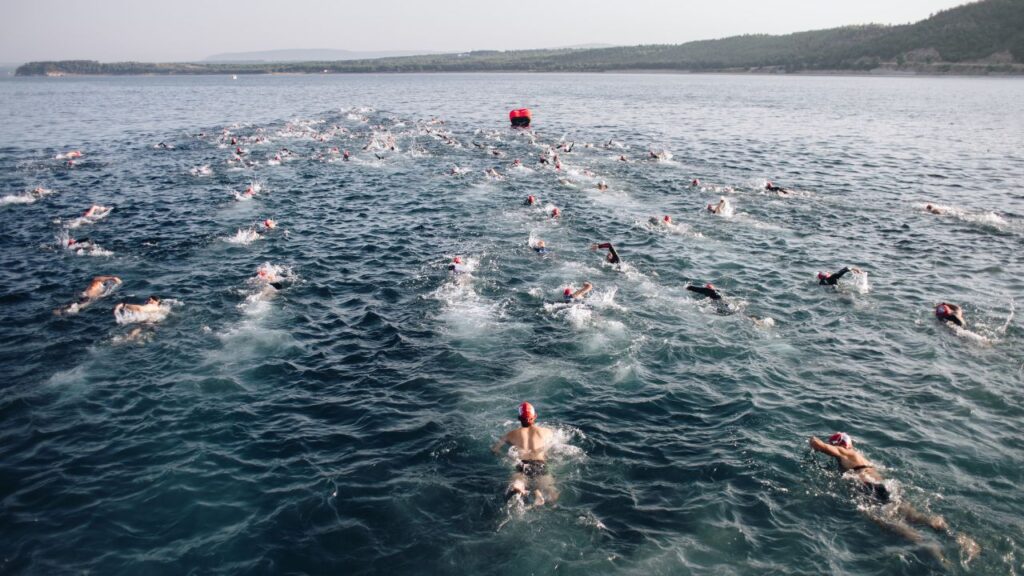Swimming long distances take a hatful of muscle, confidence, and courage. For sure! You have to swim at the proper pace like a maniac. But the point is how to swim long distances. Swimming itself is a very challenging activity. Yet more or less, everyone can swim within their comfort zone.
But when it comes to open water swimming, it’s a whole different animal. And it’s okay to shudder at the thought of swimming more than 1500 meters. Take it easy; there are thousands like you. Well, knowing the proper approach and technique for swimming long races can save you.

What Distance Is Considered Distance Swimming?
The first prerequisite to mastering distance swimming is understanding how far to swim. Basically, any swimming distance of more than 1500 meters is considered distance swimming. In any open water event, the distance can also be 5000 meters and 10000+ meters.
Actually, it varies depending on where you are swimming. Some longer-distance swimming races are from 24 km to 67 km and even in the 80 km range.In any pool event, the distance can be 400 meters, 800 meters, and 1500 meters. The global home of aquatic sports, FINA regulates distance swimming for 5 km, 10 km, and 25 km races.
Moreover, the distance is different for different swimmers. A 500-meter swim can be dreamlike to sprinters who often participate in pool competitions. Then again, a regular swimmer in the ocean may find the 15-km swim an enjoyable activity.
Techniques to Follow to Swim Long Distance: Find Out the Secrets!
Long-distance swimming is not limited to any specific rules and techniques. There are endless ways to build long-distance swimming skills. As a novice swimmer, it may seem a mystery to you. So, let’s unfold the mystery and follow the guide below.
Warm Up Muscles
Before jumping into the water, prepare your body for the actual game. Loosen your muscle and perform a dynamic warm-up. You can perform skipping, jumping rope, core exercises, warm-up stretches, etc.
This will help the blood to flow throughout the body. Besides, these works on those hard-to-reach muscles and increase body temperature to prepare your body to swim.
Decide what Stroke to Emphasize
Round-arm freestyle stroke and breaststroke are suitable for most long-stance events. Among both, round-arm freestyle is the most efficient. Here is how to perform a round-arm freestyle stroke.
How to Perform a Round Arm Freestyle Stroke?
- Keep your arm in a position as if you are holding an exercise ball
- Take the arm at a slight angle into the water
- Arm has to be straightened once under the water
- Follow the 1st step during the recovery phase
- Perform two-beat kicks just like kicking the motor with your legs
- While sparing your right hand into the water, kick your left leg
- Make sure to kick with power from the hips, not the knees
- Maintain a correct body position, e.g., flat and horizontal at all times
- Keep Elbows lifted in a vertical position while pushing water behind
Know your Limit
While long-distance swimming, knowing how far you can go is essential. You need to have a good speed with enough endurance. So, you can survive till the last.
You’ll likely don’t want to waste all your energy at the beginning. This way, you won’t get tired and slow down to the end. Give yourself a minute after each set. For the most part, a 40-second interval is enough to push yourself.
A Little at a Time
Let’s start gradually, a little at a time. Keep it reasonable. Simply put, you might want to perform a set of short distances. Start with a few meters daily and gradually improve it every week and month.
Slow improvement is good for the long run. Plan how much you want to perform each week. You can start doing 100m daily, then work up to 200m, 400m, 500m, 1000m, etc.
For example, you can swim 500 meters by following the sets listed below separately.
- 25m 3 times
- 50m 2 times
- 75m 3 times
- 100m 1 time
Gradually increase the strokes in each set every week, such as 1000m, 1500m, and more. You’ll noticeably find a significant difference on all fronts. When you become a pro, you can expand the sets to 5×300 or 5×400.
Breathing Control
They say; the less you breathe, the further you can go. Breathing is really very important in long-distance swimming. Your muscles need enough oxygen to perform at optimum levels.
That doesn’t mean you have to breathe in and out in every stroke. Your goal should be maintaining deep and calm breathing throughout the swimming duration. All you have to do is find a breathing pattern that works for you.
Some average swimmers breathe every two, three, and four strokes. Conversely, most expert swimmers breathe just once or twice or none during a one-mile race. It would definitely not be reasonable for you.
How to Breathe While Swimming?
This is how you can breathe while swimming long-distance.
- Keep your head up and your legs and hips underwater while swimming.
- Don’t inhale, and exhale quickly above the water.
- Exhale with your head under the water and inhale when you come out.
- Breathe once in every one arm cycle or two strokes. Breathing more often is essential for overall endurance.
- Last, of all, one-sided breathing is highly recommended for long-distance swimming. It gives your body a good amount of oxygen.
Do and Don’t of Long-distance Swimming
| Do’s | Don’t |
| Drink right, eat tightWork on your fitnessMaintain a workout schedule keep one or two days for rest, and reduce the rest interval gradually improve your strokes and increase the distance over time create a stroke plan and stick to it! Focus on your speed and endurance at a time focus on breathing and record your swim speed swim with a friend | Never swim alone in open water. Do not jump into the water if the weather feels unsafeAvoid expanding relaxing time as it may make the distance toughDon’t swim long strokes at onceDon’t drive yourself to the point of exhaustion. Don’t waste your energy on kicking needlessly. |
To Sum UP
Distance swimming can be mentally exhausting if you are not prepared. Knowing how to swim long distances will make it fun and thrilling. Follow the tips and techniques above and keep at them. Last but not least, practice… practice… and more practice!
